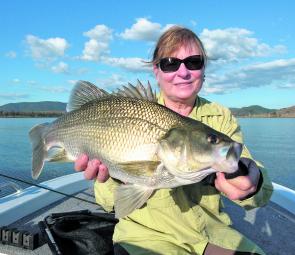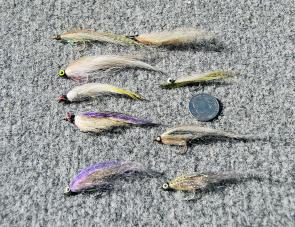Bass on fly tackle are a no brainer these days. When things are tough on the bass championship circuit, anglers often resort to the fly to take out line honours, proving that it’s indeed an effective method. Still, we anglers are always keen to catch a bigger fish rather than just average ones, and that’s what this article is about. If it works for the competition angler it can work for you.
While many of our streams hold good stocks of bass, finding and catching larger specimens is never going to be as easy as casting a fly in an impoundment. That said, selecting the right impoundment is important because recognized bass dams don’t all hold larger fish. Maroon Dam, for instance, is a great place to fly fish for bass – it offers quite unique dry fly fishing – but there are very few fish over 40cm. By contrast Moogerah Dam, just across the way, holds ample fish in the vicinity of 50cm these days, as do Lakes Somerset, Wivenhoe and Borumba up Gympie way.
It’s a fair question to ask why Maroon Dam has plenty of smaller bass while the others mentioned seem to hold schools of much larger fish. The answer is as simple as looking at the food sources. Maroon Dam has crayfish and fire-tail gudgeons while the other impoundments hold tonnes of bony bream along with the crustaceans.
With that in mind it’s pretty obvious that catching larger bass accustomed to gorging on bony bream will involve using larger flies. That takes care of fly selection: go larger or miss the fun!
Big bass school up at this time of year (and into spring) because their breeding instincts drive them to congregate. Schooling makes them easier to find on the sounder, and from my experience in all of the major bass impoundments the schools of fish follow a pattern of holding close to the original river or creek bed. It’s an easy starting point with the sounder on the job. If you’ve invested some time in a series of zigzag passes and still haven’t found the fish, try checking out flats or points around the drowned river bed. Somerset Dam’s renowned Pelican Point sees the river bed extending around this point on three sides – north, east and south – and the fish are usually located right by the old Stanley River bed on one of the sides of the point or other.
Whichever impoundment you fish, finding the bass is always the initial prerequisite as there are very few bass taken casting blind. With bass there are usually either plenty or very few. Hint: keep checking the 10m depth area as bass seem to favour schooling up at that depth for some reason.
Even when targeting larger bass you shouldn’t be in a rush to set up mega tackle. Lots of 50cm or larger bass are taken on 6 or 7wt outfits, with the 7wt my pick of the two. The 7wt is still an easy rod to cast for extended periods (sorry, there won’t be a fish every other cast!) and it has just that bit of extra grunt when it comes to casting a full sink fly line and a fly around the size of a small bony bream.
The fly line should have a uniform fast sink capability. The Scientific Anglers Striper IV was THE fly line for the job but these days it’s the SA Express Streamer that seems to get the fly down quickly to where the schooled fish are holding.
A tapered leader of around a rod’s length is the go. If you don’t make your own tapered leaders there’s nothing wrong with a store bought job so long as it sinks.
Bony bream style flies don’t need to be exact imitations so far as colour goes, you just want a near enough profile. Big Clousers will work, as will large minnow-style offerings, and don’t overlook the Bass Vampire style of fly. My guess is that these flies have some resemblance to a small yabby, hence their attraction, so a couple of Vampires in the fly box is important.
Freshwater is kind on fly tackle, so a quality freshwater reel that can hold at least 50m of backing is ideal. Hint: the larger the arbor on the reel the less issues with the fly line kinking or holding memory on a cool morning. Leave the dinky reel for the trout; go for a larger one for bass.
Once you’ve found the fish, make as long a cast as possible. This will see the fly down in the water column and able to be retrieved for some distance among the fish rather than being brought directly under the boat where it won’t be down in the strike zone for long. When the fly line all extends onto the water after that really good cast is made, count the fly down as per the sink rate on the fly line’s box. This should see it down in the strike zone – and then comes the all-important retrieve.
With the rod tip right down on or into the water to keep all slack out of the equation, strip the fly back in small, sharp movements. When a fish is interested there will usually be either a sharp pick (you’ve just missed that hook-up) or a solid thump (the fish has taken hold). If you get the pick, slip the fish a couple of metres of slack line as quickly as possible. This will often see Mr Bass come back for another shot (maybe they think that the fly has been wounded?) and you have got him.
Once a bass is on it’s just a matter of being patient and wearing the fish down until it comes to the net. Big bass on fly tackle will give a very good account of themselves, and it’s smart to set up with a 5-6kg tippet to avoid break-offs and spooking the school.
So there you have it. Imagine a bass impoundment on a cool morning, a bit of fog coming off the water, the sounder’s screen lighting up with lines of feeding bass… the coffee bag handy for a brew and a bikkie later. Does it get any better? When that rod is being pulled out of your hand by a feisty big bass, it just has!
Reads: 4844
That’s 54cm of bass taken by Denise Kampe on a bony bream style fly.

Some of the author’s rough but effective flies. The colours don’t mimic bony bream but the profile is enough to fool the fish.

Denise Kampe with a brace of big bass from Lake Somerset.




